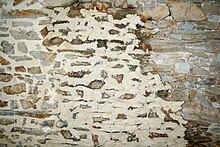
Back Calsina AN نورة (مادة) Arabic Koichmaitl BAR Argamassa Catalan Kalkmørtel Danish Kalkmörtel German Mortero de cal Spanish Kareore Basque ملات آهک Persian Kalkkilaasti Finnish

Lime mortar or torching[1][2] is a masonry mortar composed of lime and an aggregate such as sand, mixed with water. It is one of the oldest known types of mortar, used in ancient Rome and Greece, when it largely replaced the clay and gypsum mortars common to ancient Egyptian construction.[3]
With the introduction of Portland cement during the 19th century, the use of lime mortar in new constructions gradually declined. This was largely due to the ease of use of Portland cement, its quick setting, and high compressive strength. However, the soft and porous properties of lime mortar provide certain advantages when working with softer building materials such as natural stone and terracotta. For this reason, while Portland cement continues to be commonly used in new brick and concrete construction, its use is not recommended in the repair and restoration of brick and stone-built structures originally built using lime mortar.[4]
Despite its enduring utility over many centuries (Roman concrete), lime mortar's effectiveness as a building material has not been well understood; time-honoured practices were based on tradition, folklore and trade knowledge, vindicated by the vast number of old buildings that remain standing. Empirical testing in the late 20th century provided a scientific understanding of its remarkable durability.[5] Both professionals and do-it-yourself home owners can purchase lime putty mortar (and have their historical mortar matched for both color and content) by companies that specialize in historical preservation and sell pre-mixed mortar in small batches.[6]
- ^ "What is torching?". www.lime.org.uk. Retrieved 2022-06-12.
- ^ "What is Roof Mortar Torching?". JDB Surveying & Architectural. 2021-02-02. Retrieved 2022-06-12.
- ^ Lucas, A (2003). Ancient Egyptian Materials and Industries. USA: Kessinger Publishing, LLC. p. 584. ISBN 0-7661-5141-7.
- ^ US Park Service Preservation Brief 2
- ^ Peter Ellis, The Analysis of Mortar: The Past 20 Years, 2002
- ^ "US Heritage Group". US Heritage Group. Retrieved 2020-04-04.
© MMXXIII Rich X Search. We shall prevail. All rights reserved. Rich X Search